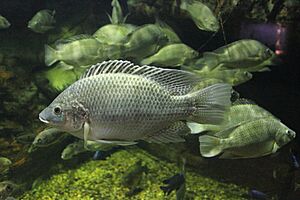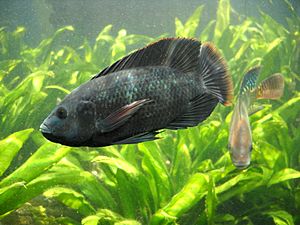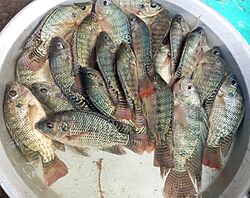Mozambique tilapia facts for kids
Quick facts for kids Mozambique tilapia |
|
|---|---|
 |
|
| Conservation status | |
| Scientific classification | |
| Synonyms | |
|
The Mozambique tilapia (Oreochromis mossambicus) is a type of cichlid fish. It comes from southeastern Africa. These fish are not brightly colored. They can live for about ten years in their natural homes.
Mozambique tilapia are popular for aquaculture, which is like fish farming. People have moved them to many warm places around the world. In some new places, they can become an invasive species. This means they spread quickly and can harm local fish. But their tough nature also makes them good for farming. In Colombia, they are called black tilapia. In South Africa, they are known as blue kurper.
Contents
About the Mozambique Tilapia
The Mozambique tilapia has a body that is flat from side to side. It has a deep body with long fins on its back. The front part of these fins has spines.
Their natural color is a dull green or yellow. You might see faint stripes on their bodies. Adult fish can grow up to 39 cm (15 in) long. They can weigh up to 1.1 kg (2.4 lb). Their size and color can change depending on where they live. They can live for up to 11 years.
Where They Live and Grow
Mozambique tilapia live in rivers and coastal waters in southeastern Africa. This includes areas from the Zambezi River in Mozambique, Malawi, Zambia, and Zimbabwe. They are also found in the Bushman River in South Africa.
In their native homes, they are now threatened by the Nile tilapia. The Nile tilapia was brought there by humans. These two fish compete for food and space. They also hybridize, meaning they breed together. This could make pure Mozambique tilapia disappear from some rivers.
This fish is very strong and can have many babies. It easily finds food and breeds even in tough conditions. They live in rivers, streams, canals, ponds, lakes, and swamps. They can also live in estuaries, where fresh and salt water mix. They usually avoid fast-moving water or very high places. They like water temperatures from 17 to 35 °C (63–95 °F).
When Tilapia Become Invasive
Mozambique tilapia, or mixes of this species, are invasive in many parts of the world. They have escaped from fish farms or were put there to control mosquitoes. The Invasive Species Specialist Group has named them one of the 100 worst invasive species.
They can harm local fish by competing for food and nesting spots. They also eat small fish directly. In Hawaii, they threaten the striped mullet. In California, they might be causing the decline of the desert pupfish.
How Tilapia Hybridize
Mozambique tilapia can easily hybridize with other tilapia species. This means they can breed with different types of tilapia. Fish farmers often crossbreed them. Pure Mozambique tilapia grow slowly and are not shaped well for large fillets.
However, Mozambique tilapia are very good at living in salty water. Also, some hybrid mixes, like with Wami tilapia, produce mostly male fish. Male tilapia are better for farming because they grow faster. The "Florida Red" tilapia is a popular mix of Mozambique and blue tilapia.
Tilapia Behavior
What Tilapia Eat
Mozambique tilapia are omnivorous, meaning they eat both plants and animals. They can eat tiny bits of dead plants and animals. They also eat tiny algae, small water bugs, and even small fish. They will also eat plants, from large algae to rooted plants. This wide diet helps them live in many different places.
Because they are so tough, Mozambique tilapia often take over their habitat. They can become the most common fish in an area. If there are too many fish and not enough food, adults might eat the young. They are opportunistic eaters, meaning they eat whatever is easiest to find. In fish farms, they can learn to get food from special feeders. They might even jump out of the water for food.
Tilapia Social Life
Mozambique tilapia often swim in groups. These groups have a clear social order, like a pecking order. Fish higher in the order are more likely to defend their space. They also court more, build bigger nests, and are more aggressive.
During breeding season, males gather in shallow water. They form a dense group called a lek. Females then choose their mates from this group. Males with higher social status are more successful at breeding.
Studies show that dominant males are more aggressive. They pick fights more often than lower-ranked males. But they tend to fight fish that are very different in rank, not those close to them. This might be because fighting fish of similar rank is risky. Dominant fish prefer easy wins to keep their status.
Communication and Aggression
Mozambique tilapia use their urine to communicate. Hormones and pheromones in the urine can affect other fish. Dominant males use a smell in their urine to signal females. Females can tell the difference between dominant and lower-ranked males by these chemicals.
Urine also plays a role in how males interact with each other. More urination is linked to more aggression between males. Dominant males release stronger urine during fights. This suggests that urine helps form and keep the social order.
Fights between males usually start with visual signals, sounds, and touches. If no one backs down, it can lead to physical fighting. But fights are risky and can cause injuries. To avoid injury, fish often use rituals that cost a lot of energy. This way, only strong fish can keep up the fight.
Reproduction and Life Cycle
The male Mozambique tilapia digs a nest. The female then lays her eggs in it. The male then fertilizes the eggs. After this, the female puts the eggs in her mouth. She keeps them there until they hatch. This is called mouthbrooding.
Mozambique tilapia are considered an invasive species partly because of how they reproduce. They take good care of their young. They can also lay many batches of eggs over a long breeding season. This helps them succeed in different places.
In the lek system, males gather to show off and attract females. Dominant males are usually bigger and more aggressive. They are better at defending their space. They also build larger nests. During courtship, males make sounds to attract females. Females are drawn to dominant males who make lower sounds. After mating, males guard the nest. Females carry the eggs in their mouth. This allows the young to be moved to different places. These strong breeding methods help them spread.
Male Mozambique tilapia try to breed at the same time. This helps them take advantage of when females are ready to lay eggs. But this also means more competition among males. So, males have different ways to find a mate. Some smaller males might pretend to be females. They try to sneak in and breed when the dominant male is busy. Other males might just swim between territories looking for a mate. Still, the dominant males usually have the most success.
Parental Care
Mozambique tilapia mothers usually carry their eggs and young in their mouths. This is called maternal mouthbrooding. So, the mother does most of the parental care. Males help by building nests, but this takes less energy than mouthbrooding.
Mouthbrooding takes a lot of energy from the mother. She loses body weight and energy. To save energy, females stop their egg growth while mouthbrooding. Even so, caring for the young is hard on the mother. Unlike most fish, Mozambique tilapia mothers care for their young for a longer time. This might help the young form social bonds.
Using Tilapia in Fish Farming

Mozambique tilapia are tough fish that are easy to raise and harvest. This makes them good for aquaculture (fish farming). Their meat is mild and white, which people like to eat. This species makes up about 4% of all tilapia farmed worldwide. But they are more often mixed with other tilapia species.
Tilapia can get diseases like whirling disease and ich. However, Mozambique tilapia are resistant to many water quality problems and pollution. Because of this, they are used to test how toxic metals are in South African rivers.
In 2013, some Mozambique tilapia were sent into space on the Bion-M No.1 spacecraft. Sadly, they all died because of equipment failure.
Other Names for Tilapia
This fish is known by a few other names:
- Mujair in Indonesia. This name comes from a Javanese fish breeder named Moedjair.
- Daya in Pakistan.




